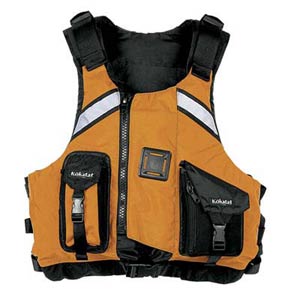|
In purchasing equipment for the outdoors, I always use the same  thought process. How often am I going to upgrade my equipment based on the new radical improvements that
the manufacturer will come out with? How long before my existing equipment will become obsolete and I
will have to replace it? How long will it be before I have a disadvantage with my existing equipment? When the time came to choose a PFD, I decided that I would choose the best PFD that I could afford based on the use of the PFD.
thought process. How often am I going to upgrade my equipment based on the new radical improvements that
the manufacturer will come out with? How long before my existing equipment will become obsolete and I
will have to replace it? How long will it be before I have a disadvantage with my existing equipment? When the time came to choose a PFD, I decided that I would choose the best PFD that I could afford based on the use of the PFD.
Always wear your PFD for kayaking, canoeing, etc. During an emergency, you WILL NOT be able to put your PFD on in the water. The failure to wear a personal flotation device (PFD) will potentially lead to a dangerous situation.
Coast Guard Type PFD
Design standards have been set up by the Coast Guard and the Type III PFD is the PFD that you will most likely see people using for kayaking and canoeing. Unlike the Type I and Type II, the Type III PFD will not float you face-up automatically. If your paddling partner is in the water and is face down, get to your partner as fast as possible as your partner will remain in that position if unconscious. This PFD is very comfortable, has a close fit and gives you freedom to paddle comfortably.
Fitting the PFD
A loose fitting PFD will lead to disaster as you will have a good chance of drowning because your nose and mouth will not be high enough to stay out of the water. Don't confuse a tight fitting PFD with a PFD that is too small as it should be snug and comfortable, allowing you to paddle easily.
The PFD test
First make sure the PFD will fit over different clothing that are worn during all four seasons (if you intend on paddling in all seasons). The PFD should have enough adjustment straps under the arms, around the chest, on top of the shoulders and around the stomach to allow enough room for an assortment of clothing such as a t-shirt, paddling jacket, fleece, spray skirt, wet suit, dry suit, etc. Put on the PFD and make all the adjustments until the PFD is snug fitting. Lift up your arms, while on your knees and have another person lift the PFD by the shoulder straps. If the top of the PFD lifts up to your chin, this one is too large for you. Try the next smaller size and try the PFD test again.
PFD color
Make sure the color of the PFD can be seen from far away. Yellow is an excellent color choice while black is not. If there is an emergency, you want the color to aid in your rescue.
Storage pockets and hooks
Make sure there are enough pockets and hooks to store all the important safety items that need to be in the PFD - whistle, power food bar, flares, VHF radio, knife, compass, money, extra glasses, binoculars, water, light, etc.
Reflective tape
Some PFD's will have reflective tape that can be seen at dusk or at night when a light is shined on the PFD. The reflective tape will be very helpful during an emergency or when paddling at night.
Don't forget to learn how to maintain your PFD correctly because incorrect methods might damage your PFD and choose a PFD wisely.
| 
